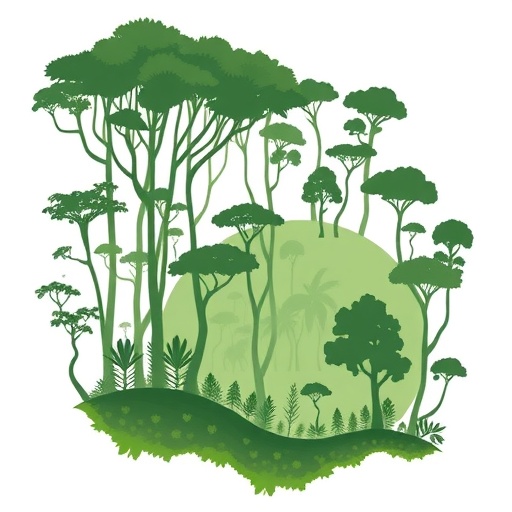A groundbreaking study has emerged, emphasizing the critical impact of human activity on the Amazon rainforest’s ecological fabric, with implications that stretch far beyond its carbon-sequestering abilities. As delegates gather at COP30 to confront climate challenges, it’s essential to recognize that the Amazon’s value extends well into the realm of biodiversity. The rainforest is not merely a reservoir of carbon; it serves as a sanctuary for an astonishing array of life, with an estimated 16,000 tree species thriving in its expanse. Such incredible diversity starkly contrasts with the paltry 32 native tree species found in the UK and a collective 450 species across Europe.
A research team made up of international experts from Brazil and the UK, spearheaded by scientists from Lancaster and Oxford universities, recently published their findings in the prestigious journal Global Change Biology. Their work meticulously cataloged more than 55,000 trees across 215 plots within two regions of Eastern Amazonia. These plots were selected to represent various levels of human interference, from pristine primary forests untouched by logging and fire to those that have experienced selective logging or complete clear-cutting. This structured approach allowed researchers to document the nuanced shifts in tree diversity and forest functionality prompted by human activities.
Initial findings revealed that human disturbances severely disrupt tree species diversity, moving beyond mere numbers to affect the ecological roles trees play in these ecosystems. This transformation is not just quantitative—it’s about the very identities of the trees that populate the forest. Through their work, the researchers illustrated that even purportedly sustainable practices like selective logging have detrimental impacts on tree diversity, a fact that resonates with alarming implications for forest conservation. The expectation is that a richer diversity of species and functional types contributes to forest resilience. However, the evidence shows that logged and disturbed forests experience significant losses in both diversity and functional capacity.
Previous methodologies aimed at assessing biodiversity have typically focused on two principal approaches: one is the functional diversity assessment that ties tree species traits—such as wood density and leaf area—to their ecological functions within the forest ecosystem. The other method employs phylogenetic analysis, assessing interspecies relationships based on evolutionary lineage. In light of the new findings, Dr. Erika Berenguer, the study’s co-lead, emphasized that these scientific advancements may end up overshadowed by the sheer scale of human disruption. Indeed, the narrative shifts from measuring diversity to recognizing that disturbance itself dictates these changes.
The researchers meticulously documented tree diversity in terms of species, function, and evolutionary lineage, providing a comprehensive understanding of how human interference alters forest ecosystems. Interestingly, while disturbed primary forests exhibited lower species numbers, it was the identity and ecological roles of the trees that underwent significant transformation. The fossil record hints that logging and burning lead to an increased prevalence of fast-growing pioneer species, while slower-growing, larger species, integral to the old-growth forests, become increasingly rare.
As pressure mounts on the Amazon from ongoing human activities, the study raises a stark warning: the distinctions between undisturbed and human-modified forests grow increasingly pronounced. The implications are not limited to biodiversity; they extend to the ecosystem services these forests provide. This includes not only carbon storage but also essential habitat for myriad organisms, indicating a complex web of life is at risk due to human encroachment.
The research team highlighted that degraded forests, while still functional, lacked the robustness present in their undisturbed counterparts. Thus, conservation efforts must not solely target untouched areas but also include strategies for sustainable management of disturbed regions. This perspective aligns with increasing recognition of the Tropical Forest Forever Facility (TFFF), an innovative funding mechanism designed to support all forests, regardless of their current status.
Professor Jos Barlow emphasized the urgent need to safeguard the remaining pockets of unaltered forest as pressures intensify. Preserving these areas is vital, not merely for carbon-sequestration potential but to maintain the evolutionary heritage that underscores the Amazon’s biodiversity. The challenge lies in realizing that ecological health will play a pivotal role in the forest’s ability to combat climate change.
This research illuminates not just the challenges but pathways forward. By acknowledging the intrinsic link between biodiversity and climate, the broader discourse surrounding COP30 can expand. Protecting the Amazon’s biodiversity is foundational to fostering the resilience of its ecosystems and ensuring that these systems can continue to mitigate the impacts of climate change effectively.
The ramifications of this research extend into the future of conservation. The Amazon rainforest stands at a crossroads, presenting an opportunity to rethink traditional conservation methodologies and foster a deeper understanding of the interplay between human activity and ecological integrity. It is increasingly clear that any successful approach to climate action must embrace the invaluable benefits derived from preserving biodiversity alongside traditional carbon-centric metrics.
In conclusion, the need for holistic solutions is evident. The thread of biodiversity interwoven within the Amazon rainforest encapsulates a crucial narrative in the fight against climate change. Upcoming discussions, particularly during global gatherings like COP30, must include biodiversity alongside carbon metrics, highlighting the Amazon’s role not only as a carbon sink but as a vital sanctuary for life. Understanding and preserving this intricate web of life in the Amazon will be paramount in our collective efforts to navigate the climate and biodiversity crises.
Subject of Research: Human impact on the Amazon rainforest and its effects on biodiversity.
Article Title: Multi-faceted assessment of Amazonian tree diversity reveals pervasive impacts of human modifications.
News Publication Date: 10-Nov-2025
Web References: DOI link
References: Global Change Biology
Image Credits: Cássio Alencar Nunes
Keywords
Amazon rainforest, biodiversity, climate change, conservation, human disturbance, ecological resilience, tree diversity, sustainable management.




